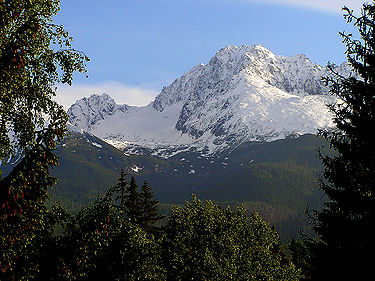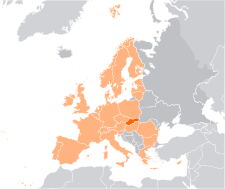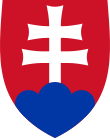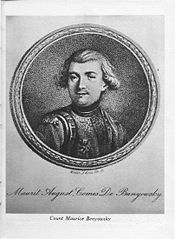- Portal:Slovakia
-
- Wikipedia portals:
- Culture
- Geography
- Health
- History
- Mathematics
- Natural sciences
- People
- Philosophy
- Religion
- Society
- Technology
The Slovakia Portal
Slovakia or the Slovak Republic (Slovak: Slovensko, Slovenská republika) is a landlocked republic in Central Europe with population of more than five million. It is a member of the European Union (since May 1, 2004) and borders Czech Republic and Austria in the west, Poland in the north, Ukraine in the east and Hungary in the south. Its capital is its largest city, Bratislava.
From around 450 BC, the territory of modern-day Slovakia was settled by Celts, who built powerful oppida in Bratislava and Liptov. Silver coins with the names of Celtic kings represent the first known use of writing in Slovakia. From 6 AD, the expanding Roman Empire established and maintained a chain of outposts around the Danube. The Kingdom of Vannius, a barbarian kingdom founded by the Germanic tribe of Quadi, existed in western and central Slovakia from 20 to 50 AD.
The Slavic population settled in the territory of Slovakia in the 5th century. Western Slovakia was the centre of Samo's Empire in the 7th century. A proto-Slovak state, known as the Principality of Nitra, arose in the 8th century and its ruler Pribina had the first Christian church in Slovakia consecrated by 828. Together with neighboring Moravia, the principality formed the core of the Great Moravian Empire from 833. The high point of this (Proto-)Slovak empire came with the arrival of Saints Cyril and Methodius during the reign of Prince Rastislav and the territorial expansion under King Svätopluk.
Selected article
Gerlachovský štít (translated into English as Gerlachov Peak, Gerlachovský Peak or Gerlach Peak) is the highest peak in the High Tatras, in Slovakia, and in the whole 1,500 km (900 mi.) long Carpathian mountain chain, as well as in northern and eastern Central Europe.


The south face of Gerlachovský štít, the highest peak of Slovakia. Usually listed at 2,655 metres AMSL (8,711 ft), its exact elevation is actually 0.6 metres (2 ft) lower. The pyramidal shape of the massif is marked by a huge cirque. Despite its relatively low elevation, the about 2,000 m vertical rise from the valley floor makes Gerlachovský štít soar. Mistaken for an average mountain in the rugged High Tatras range in the more distant past, it has since played a symbolic role in the eyes of the rulers and populations of several Central European nations, to the point that between the 19th and mid-20thcentury, it had four different names with six name reversals. It managed to be the highest mountain of the Kingdom of Hungary, and of the countries of Czechoslovakia and Slovakia within the span of only about two decades of the 20thcentury.
Gerlachovský štít shares its geology and ecology with the rest of the High Tatras, but provides a worthwhile environment for biologists as the highest ground anywhere in Europe north of the parallel linking approximately Munich, Salzburg, and Vienna. The mountain used to be particularly treasured as the loftiest point to climb to by Czechs, eastern Germans, Hungarians, Poles, and Slovaks during the period of restricted travel in the 20th century. It continues to attract its share of visitors although the local authorities have been continually adding new restrictions on access.
Selected picture


The Bojnice Castle is located above the town of Bojnice and is one of the country's tourist attractions. Bojnice Castle is a castle in Bojnice, Slovakia. It hosts the single most popular museum in Slovakia and has been featured in many movies. Bojnice Castle was first mentioned in written records in 1113, in a document held at the Zobor abbey. Originally built as a wooden fort, it was gradually replaced by stone, with the outer walls being shaped according to the uneven rocky terrain.
Categories
- History of Slovakia
- Archaeological sites — Great Moravia — Slovak nobility — Elections — Traditional regions — Austria-Hungary — Czechoslovakia
- Subdivisions of Slovakia
- Geography of Slovakia
- Mountain ranges — Rivers — Cities and towns — Villages
- Slovak culture
- Art — Cuisine — Literature — Theatre — Media — Music — Czechoslovakia — Sport — Religion
Slovak editions of Wikimedia projects
Did you know...
- ...that Mount Urpín is home to 35 endangered animal species, despite its proximity to downtown Banská Bystrica?
- ...that the first film to take advantage of the relaxation of communism in Czechoslovakia in the 1960s was The Sun in a Net?
- ...that the Trinitarian Church in Bratislava was built on the place of an older settlement which was demolished in 1529 due to the Ottoman wars?
- ...that Slovak Paradise National Park is home to more than 2,100 species of butterfly, resulting in the highest concentration in Slovakia?
- ...that tajchy, a network of 60 water reservoirs and more than 100 km of channels, was built in the 1700s to drain flooded silver mines in Banská Štiavnica?
- ...that of 43 people on board, the sole survivor of the 2006 Slovak Air Force Antonov An-24 crash was in the toilet at the time of the crash?
- ...that archaeologists discovered bones of at least seven people sacrificed by druids in Havránok?
Selected biography
Móric Beňovský (born 1741 or 1746 as Móritz Benyovszky - died May 23, 1786) was a Slovak noble in the Kingdom of Hungary, adventurer, globetrotter, explorer, colonizer, writer, chess player, the King of Madagascar, a French colonel, Polish military commander and Austrian soldier.
Beňovský was born in Vrbové near Trnava in present-day Slovakia (at that time part of the Kingdom of Hungary). The year of his birth (1741 or 1746) is disputed. His career began as an officer of Austrian army in the Seven Years' War, because Hungary was part of the Austrian monarchy at that time. However, his religious views and attitudes towards authority resulted in his leaving the country. From this time on he was called a sailor, an adventurer, a visionary, a colonizer, an entrepreneur, and a king.
In 1768 he joined the Confederation of Bar, Polish national movement against Russian intervention. He was captured by the Russians and interned in Kazan and later exiled in Siberia (Kamchatka). Subsequently, he escaped from Siberia and started a discovery trip through the Northern Pacific. In 1772 Beňovský arrived in Paris where impressed King Louis XV. He was offered to act in the name of France on Madagascar. In 1776 Beňovský was elected by the local tribal chiefs an Ampansacabe, (king) of Madagaskar. In 1776 he returned to Paris and in appreciation for his services as Commander of Madagascar, he was awarded with promotion to the rank of General, and granted the military Order of Saint Louis and a life pension by Louis XVI. In 1779 Beňovský came to America, where he tried to obtain support in proposal to use Madagascar as a base in the struggle against England. He died in 1786 fighting with the French on Madagascar.
More about Móric Beňovský ...Things you can do
Related portals
Associated Wikimedia
Find more information on Slovakia by searching one of Wikipedia's sister projects:
 Dictionary definitions from Wiktionary
Dictionary definitions from Wiktionary
 Textbooks from Wikibooks
Textbooks from Wikibooks
 Quotations from Wikiquote
Quotations from Wikiquote
 Source texts from Wikisource
Source texts from Wikisource
 Images and media from Commons
Images and media from Commons
 News stories from Wikinews
News stories from Wikinews- Wikipedians in Slovakia
Categories:- Slovakia
- European portals
Wikimedia Foundation. 2010.




